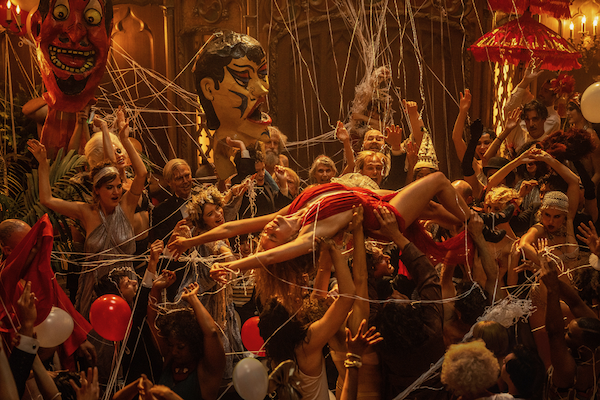Movie review by Greg Carlson
How many “Babylon” reviews and essays will at some point use the words orgiastic and overlong to describe Damien Chazelle’s raucous Hollywood fable? To date, the filmmaker remains the youngest winner of the Oscar for Best Director, which he received for “La La Land” during a ceremony enshrined in Academy legend for the embarrassing Best Picture envelope gaffe at the end of the telecast. That film, which also mines movie-mad dreamscapes, cemented Chazelle’s status as a top-tier storyteller following sophomore barn burner “Whiplash.” His latest, a wild and uneven quasi-epic that ogles stardom and cinephilia through the eyes of a group of characters during the tumultuous transition from the silent era to the advent of synchronous sound, is certainly hungry for attention.
The film’s length, a whopping three hours and eight minutes, could test the patience of ticket buyers who might opt instead to watch at home, where bathroom break pauses can be made on demand. “Babylon” goes big and refuses to be ignored, even if a much better, much shorter movie exists somewhere inside the messy sprawl. Among the ensemble, Margot Robbie and Brad Pitt command the most scrutiny based on star power, but Diego Calva’s Manny Torres serves as the point of audience identification. Several other supporting players, including Jovan Adepo’s jazz trumpeter and Li Jun Li’s intertitle writer/chanteuse, seem at first to point in the direction of an interlocking narrative structure that never fully materializes.
Despite good intentions, Chazelle’s approach to the inclusion of historically marginalized characters of color partially backfires. Calva ends up with more screen time than either Adepo or Li – whose Lady Fay Zhu was based in part on Anna May Wong – but the climactic “Cinema Paradiso”-style montage that Chazelle offers as an affirmation of the magnificent, life-altering power of the art of the motion picture is something of a curiosity given the dark and grim critique of the soul-crushing production conditions preceding it. Are we supposed to sympathize with the once optimistic Torres, who grows increasingly bitter, disillusioned and unpleasant as he rises through the ranks?
For maximum enjoyment, movie lovers will make a sport of identifying Chazelle’s many homages and intertextual acknowledgments. Obviously, “Singin’ in the Rain” serves as inspirational sunshine to the “Babylon” thunderstorm, and Chazelle pays his respects in multiple scenes. The tragedy of the unfairly maligned Roscoe “Fatty” Arbuckle is used as the basis for a sequence of events that will launch the career of Robbie’s “wild child” Nellie LaRoy. The ghosts of Murnau, Griffith, Wellman, von Stroheim and others haunt the productions mounted at the Kinoscope studio and the milieu surrounding it.
Chazelle pays tribute to more contemporary heroes, too. The influence of Scorsese and Altman is unmistakable and one scene straight-up copies the anxious “Jessie’s Girl” drug deal gone sideways in Paul Thomas Anderson’s “Boogie Nights.” Pitt relishes the tragedy and the comedy in perpetual bridegroom Jack Conrad, his Clark Gable/John Gilbert mashup. Like Cliff Booth in “Once Upon a Time in Hollywood” – another metanarrative blending Los Angeles fact and fiction – Conrad never has to think about how incredible he looks. The actor wears the role of silver screen royalty like a finely-tailored suit.
With an explosive elephant, a golden shower, and cocaine-fueled, money-to-burn decadence, the Dionysian bender that opens the film is rivaled only by the frenetic sequence in which Nellie becomes an overnight sensation, summoning tears at will and upstaging the irritated headliner while a nearby battle scene rages before a different crew. Even though Nellie’s accent and affinity for sewer-mouthed profanity veer close to Harley Quinn, Robbie sinks her teeth into the role. To paraphrase the sentiments expressed by Jean Smart’s gossip columnist/critic Elinor St. John in the movie’s best speech, Margot Robbie will live forever.
